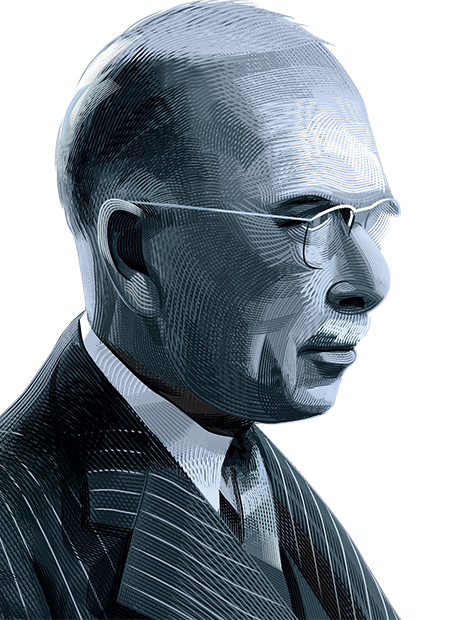Princeton’s lineage of brilliant, terrifying Chaucerians — John V. Fleming *63, D.W. Robertson Jr. — began, perhaps, with Dean Root. Robert Kilburn Root was his given name, but Dean Root is what his contemporaries left in the records, perhaps a reflection of his personal gravitas. He seems to have tried to be easygoing. At one University dinner, a guest thanked Root for his hospitality, using his title. Root said, “Ted, Ted, don’t be so formal. Call me Mr. Root.”
Dean Root came to Princeton in 1905, one of Woodrow Wilson’s original preceptors. He remained for more than 40 years, advancing to chair of the English department (1926–33) and dean of the faculty (1933–46). His was a different Princeton: Weekly services in the University Chapel began with a formal procession in which Root and his colleagues wore full academic regalia. As dean of the faculty, Root lived in the Dean’s House (now Maclean House), where the students kept tabs on his doings through the bay window. (In 1938, the Princetonian appointed him to its Honor Roll “for not drawing the curtains in his parlor and thus permitting vicarious enjoyment of his teas, bridge, and domestic reading.”) Mastery of Old English was required of every English major, which made Root’s course on the history of language (“Root’s Roots”) a well-beaten pilgrim’s path. Remarked one commentator, “Dean Root has been particularly noted for his clear and precisely organized lectures, which have unfailingly ended exactly as the bell has begun to ring at the end of the hour.”
“Imperceptibly, the arid dean disappeared, and I was talking with a person.”
In 1945, a former student of his — the late writer William Zinsser ’44 — went to Root, hoping to transfer credits from academic programs offered by the Army toward the completion of his Princeton degree. Zinsser recalled how nervous he was to ask for sanction from this stern medieval figure: “Imperceptibly, the arid dean disappeared, and I was talking with a person. Could it be the same Dean Root, this warm old man who wanted me to tell him what I had done and thought and felt in North Africa and Italy? ... At the end, a look of sadness came into Dean Root’s eyes, and he said, ‘Tell me — I suppose Siena has been mostly destroyed?’ I told him that Siena hadn’t been touched by the war and that the great striped cathedral was still there on top of the hill. Dean Root smiled and saw me to the door. ...Not long afterward, he wrote to say that I had met the requirements for a degree … .”
One benefit of a stern reputation is the opportunity to indulge in unexpected jokes. Root once shocked the audience at Class Day by describing the graduating seniors, using slang, as “476 guys.” He was letting the seniors know he was aware of the verse they gave him in the Faculty Song: “A playful lad is Robert Root / He’d like to give us all the boot. / He raised his standards up too high / And graduated just one guy.”












3 Responses
Jonathan E. Richman ’78
7 Years AgoThe Green Knight’s Tale
Reading the article on Princeton’s Chaucerians (Princeton Portrait, Sept. 12), with its introductory mention of Professors John V. Fleming *63 and D.W. Robertson Jr., immediately brought back one of my favorite Princeton memories. It took place on the first day of Professor Robertson’s fabulous Chaucer course in 1976 or 1977. Professor Robertson was ill, so a tall, thin, unidentified man appeared instead and proceeded to give a brilliant lecture on pre-Chaucerian thought and literature.
After receiving a huge ovation at the end of the class, the man asked whether anyone had any questions. A woman raised her hand and asked: “Who are you?” The man paused for several seconds, stared out at the class, and slowly declared: “I ... am the Green Knight.” He then closed his book and walked out of the room amid gales of appreciative laughter.
Thank you, Professor Fleming, for a wonderful lecture.
John C. Stone II ’53
7 Years AgoFaculty Portraits
I much enjoyed the Princeton Portrait of Dean Robert Kilburn Root (Sept. 12). Dean Root was one of many Princeton faculty members who established summer homes on Caspian Lake in Greensboro, Vt., at the end of the 19th and early 20th centuries. Occasionally the summer community was dubbed “Deansboro” in recognition of five Princeton deans: Kenneth Condit 1913, Luther P. Eisenhart, Christian Gauss 1900, Robert K. Root, and Samuel Winans 1874. There were many additional faculty members and even a president of Princeton: John Grier Hibben 1882.
Once as a youth, working under my car, I saw two legs. I crawled out and discovered that they belonged to President Harold W. Dodds *1914, who was asking for directions to Trustee S. Whitney Landon 1917 next door.
John Grier Hibben Scoon ’38, grandson of President Hibben and son of Robert Maxwell Scoon, chairman of the philosophy department, described Dean Root for me as follows: “early English literature ... wrote quite a few books ... prominent scholar in his field ... never married ... his mother lived with him ... .”
These and many other faculty members and alumni were summarized in a booklet I wrote for the Greetings and Reflections Project of Princeton’s 250th anniversary celebration in 1996: “The Princeton Connection: A Century of Princetonians in Greensboro, Vermont.” Copies are at Seeley Mudd Manuscript Library.
Arthur R. Boone ’60
7 Years AgoFaculty Portraits
To call D.W. Robertson Jr. “terrifying” seems an error. He was my thesis adviser and always welcomed me into his office in McCosh. He was very chatty, and I mostly remember him complaining that since two of his advisees were writing on Blake, he would have to read some of that stuff.
I laugh even now to consider his gentle grumbling on the subject of reading anything written after 1400. He was a sweet man.